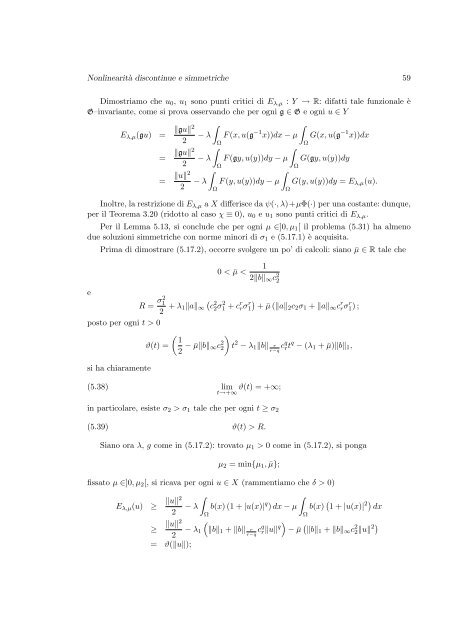Applicazioni della teoria del minimax a problemi ... - Portale Posta DMI
Applicazioni della teoria del minimax a problemi ... - Portale Posta DMI
Applicazioni della teoria del minimax a problemi ... - Portale Posta DMI
You also want an ePaper? Increase the reach of your titles
YUMPU automatically turns print PDFs into web optimized ePapers that Google loves.
Nonlinearità discontinue e simmetriche 59<br />
Dimostriamo che u0, u1 sono punti critici di Eλ,µ : Y → R: difatti tale funzionale è<br />
G–invariante, come si prova osservando che per ogni g ∈ G e ogni u ∈ Y<br />
Eλ,µ(gu) = gu2<br />
2<br />
= gu2<br />
2<br />
= u2<br />
2<br />
<br />
− λ<br />
<br />
− λ<br />
Ω<br />
Ω<br />
F (x, u(g −1 <br />
x))dx − µ G(x, u(g<br />
Ω<br />
−1 x))dx<br />
<br />
F (gy, u(y))dy − µ G(gy, u(y))dy<br />
<br />
− λ F (y, u(y))dy − µ<br />
Ω<br />
<br />
Ω<br />
Ω<br />
G(y, u(y))dy = Eλ,µ(u).<br />
Inoltre, la restrizione di Eλ,µ a X differisce da ψ(·, λ)+µΦ(·) per una costante: dunque,<br />
per il Teorema 3.20 (ridotto al caso χ ≡ 0), u0 e u1 sono punti critici di Eλ,µ.<br />
Per il Lemma 5.13, si conclude che per ogni µ ∈]0, µ1[ il problema (5.31) ha almeno<br />
due soluzioni simmetriche con norme minori di σ1 e (5.17.1) è acquisita.<br />
e<br />
Prima di dimostrare (5.17.2), occorre svolgere un po’ di calcoli: siano ¯µ ∈ R tale che<br />
R = σ2 1<br />
2<br />
posto per ogni t > 0<br />
si ha chiaramente<br />
ϑ(t) =<br />
0 < ¯µ <<br />
1<br />
2b∞c 2 2<br />
2<br />
+ λ1a∞ c2σ 2 1 + c r rσ r 1 + ¯µ (a2c2σ1 + a∞c r rσ r 1) ;<br />
<br />
1<br />
2 − ¯µb∞c 2 <br />
2 t 2 − λ1b r<br />
r−q cqrt q − (λ1 + ¯µ)b1,<br />
(5.38) lim ϑ(t) = +∞;<br />
t→+∞<br />
in particolare, esiste σ2 > σ1 tale che per ogni t ≥ σ2<br />
(5.39) ϑ(t) > R.<br />
Siano ora λ, g come in (5.17.2): trovato µ1 > 0 come in (5.17.2), si ponga<br />
µ2 = min{µ1, ¯µ};<br />
fissato µ ∈]0, µ2[, si ricava per ogni u ∈ X (rammentiamo che δ > 0)<br />
Eλ,µ(u) ≥ u2<br />
2<br />
≥ u2<br />
2<br />
= ϑ(u);<br />
<br />
− λ<br />
− λ1<br />
Ω<br />
b(x) (1 + |u(x)| q <br />
) dx − µ b(x)<br />
Ω<br />
1 + |u(x)| 2 dx<br />
<br />
b1 + b r<br />
r−q cq ru q<br />
− ¯µ b1 + b∞c 2 2u 2




![Introduzione ai sistemi Wiki [PDF] - Mbox.dmi.unict.it](https://img.yumpu.com/16413205/1/184x260/introduzione-ai-sistemi-wiki-pdf-mboxdmiunictit.jpg?quality=85)












